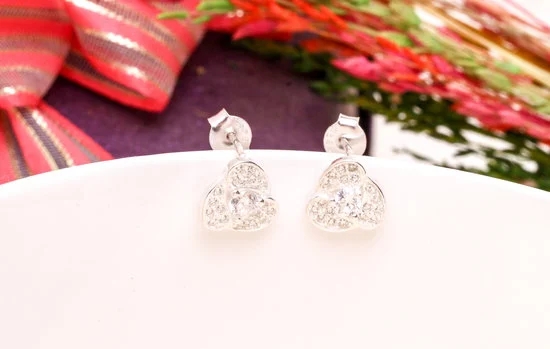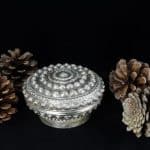The world of beaded jewelry is a vibrant and creative craft that allows you to express your unique style through beautiful accessories. And what better way to bring your vision to life than by using wire as your medium? In this article, we will explore the art of making beaded jewelry with wire, diving into the techniques, tools, and materials needed to create stunning pieces that are sure to turn heads.
Before we begin our journey into wire crafting, let’s start with a brief introduction to beaded jewelry. Beaded jewelry refers to any piece that incorporates beads, whether they are gemstones, glass beads, or even seed beads. From necklaces and bracelets to earrings and anklets, the possibilities for creating beaded jewelry are endless.
To embark on this creative adventure of making beaded jewelry with wire, it’s important to familiarize yourself with the essential tools and materials needed. Pliers, cutters, round nose pliers, and wire jigs will become your best friends in this craft. Additionally, understanding the different types of wire available – such as copper, sterling silver, and gold-filled – and their varying gauges will help you choose the right wire for each project.
As we delve deeper into this article, we will explore various techniques involved in creating beaded jewelry with wire. From basic techniques like making loops and attaching jump rings to more advanced methods like wire twisting and coiling – there is always something new to learn in this craft. So gather your tools and let’s dive into the world of beadwork intertwined with wire crafting.
Choosing the Right Wire for Your Beaded Jewelry
When it comes to making beaded jewelry with wire, choosing the right type of wire is crucial for achieving the desired results. There are several factors to consider when selecting the appropriate wire for your project, including the type of metal, wire gauge, and design requirements. In this section, we will delve into these considerations and provide tips for choosing the perfect wire for your beaded jewelry designs.
One of the first decisions you’ll need to make is what type of metal wire to use. Copper wire is a popular choice among beginners due to its affordability and versatility. It comes in various gauges and colors, allowing for endless creative possibilities. Sterling silver wire is another common option, known for its durability and classic aesthetic.
While it can be more expensive than copper, it adds a touch of elegance to any piece of jewelry. For those seeking a more luxurious option, gold-filled wire is an excellent choice. It shares many properties with solid gold but at a more affordable price point.
In addition to considering the type of metal, understanding wire gauge is essential in achieving satisfactory results in your beaded jewelry projects. Wire gauge refers to the thickness or diameter of the wire and is denoted by numbers such as 18-gauge or 24-gauge. The larger the number, the thinner the wire.
Thicker gauges offer sturdiness and are suitable for creating structural elements like clasps or frames. Thinner gauges, on the other hand, are ideal for delicate work such as making intricate loops or wrapping beads. It’s important to choose a gauge that complements your design while ensuring its strength and durability.
To help you make an informed decision when selecting your wire, refer to the table below which compares three commonly used types: copper, sterling silver, and gold-filled.
| Type | Pros | Cons |
|---|---|---|
| Copper Wire | Affordable, versatile, comes in different colors | May oxidize or tarnish over time |
| Sterling Silver Wire | Durable, classic aesthetic, adds value to the piece | More expensive than copper wire |
| Gold-Filled Wire | Luxurious look, more affordable than solid gold | Pricier compared to copper and sterling silver wire |
Essential Tools for Wire Jewelry Making
When it comes to making beaded jewelry with wire, having the right tools is essential for achieving professional results. Whether you are a beginner or experienced crafter, having a well-stocked toolbox is crucial. Here are some of the essential tools you will need for wire jewelry making.
- Pliers: Pliers are one of the most important tools for wire jewelry making. They come in various types such as round-nose, chain-nose, and flat-nose pliers. Round-nose pliers are used for creating loops and curves in the wire, while chain-nose pliers are great for gripping and bending the wire. Flat-nose pliers can be used for flattening and shaping the wire.
- Cutters: A good pair of cutters is necessary for cutting wires to your desired length. Flush cutters are recommended as they provide a clean cut without leaving any sharp edges. It’s important to invest in high-quality cutters to ensure precision and to reduce the risk of damaging your wires.
- Wire Jigs: Wire jigs are handy tools that help you create consistent shapes and forms in your wire jewelry designs. They consist of pegs or pins arranged on a board or plate where you can wrap your wire around to achieve precise shapes and angles.
- Mandrels: Mandrels are cylindrical rods made of metal or plastic that come in various sizes. They are useful for shaping and sizing rings, bracelets, or other circular components in wire jewelry making.
In order to maintain your tools’ longevity, it’s important to clean them regularly after use and store them properly to prevent rusting or damage. Additionally, investing in high-quality tools is crucial as they will provide better control and durability during the crafting process.
By having these essential tools at your disposal, you’ll be well-equipped to embark on your journey into wire jewelry making and create beautiful, intricate designs.
Basic Wire Jewelry Techniques
In this section, we will explore the fundamental techniques for creating beautiful wire jewelry designs. Whether you are a beginner or looking to improve your skills, mastering these basic techniques is essential. By following step-by-step instructions and utilizing alternative methods and tips, you will be able to achieve professional-looking results.
One of the basic techniques in wire jewelry making is making loops. Loops are versatile elements that can be used for connecting beads, creating dangles, or attaching jump rings. To make a loop, start by holding the wire with round-nose pliers about an inch from the end.
Bend the wire over the top of the pliers to form a small loop. Then, reposition the pliers to grasp the loop just made and continue bending the wire around until it meets itself. Use chain-nose pliers to adjust the shape if needed.
Attaching jump rings is another important technique in wire jewelry making. Jump rings are small metal rings with a cut opening that can be used for connecting various components together. To attach a jump ring, hold it with two pairs of pliers on either side of the opening.
Use one hand to hold one side of the opening steady while using your other hand to grip and twist the other side towards you by rotating your wrist. This twisting motion opens and closes the jump ring without distorting its shape.
Creating wire wraps is another skill that every wire jewelry maker should master. A wire wrap is a decorative way to secure beads onto a piece of jewelry or create intricate designs. To create a basic wire wrap, string a bead onto a headpin or eyepin, leaving enough excess wire for wrapping.
Use round-nose pliers to grip the wire as close as possible against the bead and bend it at a 90-degree angle away from you. Positioning your pliers above where you bent your wire, use your fingers to rotate them towards yourself to start a loop. Continue wrapping the wire around itself until it is secure and snip off any excess.
By practicing these basic techniques, you will develop the foundational skills needed for wire jewelry making. Remember to have patience and experiment with different techniques to find what works best for you. With practice and dedication, you will be able to create stunning wire jewelry designs that showcase your creativity.
| Technique | Description |
|---|---|
| Making Loops | Bending wire to form loops for connecting beads or attaching jump rings. |
| Attaching Jump Rings | Opening and closing jump rings to connect various components together. |
| Creating Wire Wraps | Decoratively securing beads onto jewelry or creating intricate designs using wire wraps. |
Designing Beaded Jewelry
Designing beaded jewelry is an exciting and creative process that allows you to express your personal style. In this section, we will explore the steps involved in planning and executing your beaded jewelry design. From understanding color theory to choosing the right beads, we will guide you through each stage of the design process.
1. Understanding Color Theory:
Color plays a crucial role in jewelry design as it can evoke different emotions and set the overall tone of your piece. To choose the right beads for your design, it’s important to understand color theory. Consider using a color wheel to guide your choices.
Complementary colors, which are opposite each other on the color wheel, create high contrast and visual interest. Analogous colors, which are next to each other on the color wheel, create harmonious and cohesive designs. Experiment with different combinations to find the perfect color palette for your beaded jewelry.
2. Planning the Layout:
Before you start stringing beads onto wire, take some time to plan out the layout of your design. Sketch out a rough draft or create a digital mockup to visualize how your finished piece will look. Consider factors such as bead sizes, shapes, and placement. You may want to experiment with different patterns or arrangements before settling on a final design.
3. Bringing Your Design to Life:
Once you have planned out your design, it’s time to bring it to life by combining wire and beads. Start by cutting a length of wire based on your desired necklace or bracelet size, leaving extra length for clasps or closures. Use techniques like making loops or wire wraps to attach your chosen beads onto the wire, following your planned layout. Take care with spacing and symmetry to ensure a professional-looking result.
By following these steps in designing beaded jewelry, you can create beautiful pieces that reflect your unique style and creativity.
Additional Tips
- Experiment with different bead shapes, sizes, and textures to add visual interest to your design.
- Consider incorporating focal beads or charms as a centerpiece for your design.
- Don’t be afraid to mix metals or combine wire and chain in your designs for added dimension.
Remember, designing beaded jewelry is a journey of self-expression and creativity. Have fun with the process and allow yourself to explore new techniques and ideas. There are endless possibilities when it comes to creating stunning jewelry with wire and beads.
Advanced Wire Jewelry Techniques for Intricate Designs
Once you have mastered the basic wire jewelry techniques, you may be ready to take your skills to the next level. Advanced wire jewelry techniques allow you to create intricate and unique designs that truly showcase your creativity. In this section, we will explore some of these techniques and provide examples and inspiration for incorporating them into your beaded jewelry designs.
- Wire Twisting: Wire twisting adds texture and visual interest to your designs. This technique involves taking two or more wires and twisting them together to create a twisted pattern. You can experiment with different wire gauges and colors to achieve different effects. To do this technique, start by anchoring one end of the wires, then hold each wire with a pair of pliers and twist them in opposite directions until they are tightly twisted together.
- Wire Coiling: Coiling is a great way to add dimension and complexity to your designs. This technique involves wrapping wire around a mandrel or dowel rod to create tight coils or spirals. You can vary the size of the coils by using different-sized mandrels or by spacing the wraps further apart or closer together. Coiled wire can be used as decorative elements, connectors, or as a base for attaching beads.
- Wire Forging: Wire forging allows you to shape wire into intricate designs by using heat and specialized tools like hammers, anvils, and mandrels. This technique gives you greater control over the shape and texture of the wire, allowing you to create unique patterns and organic forms. Forging can give your jewelry a rustic or industrial look depending on the style you desire.
By incorporating these advanced techniques into your beaded jewelry designs, you can take your creations to new heights. Remember to practice these techniques on scrap wire first before diving into your final piece. Experiment with different combinations of techniques and materials to find what resonates with your personal style.
In the next section, we will explore common issues that may arise during wire jewelry making and provide troubleshooting tips to help you overcome them.
Troubleshooting Common Issues and Tips for Success
Identifying Common Challenges
When it comes to making beaded jewelry with wire, there are certain challenges that may arise during the process. It is important to be aware of these common issues and have strategies for troubleshooting them. One common challenge is bent wires, which can occur when manipulating the wire or forming loops.
To fix this issue, gently straighten the wire using your fingers or round-nose pliers. Another common issue is loose loops, which can happen when creating wire wraps or connecting jump rings. To tighten a loose loop, use chain-nose pliers to apply pressure and bring the sides of the loop closer together.
In addition to bent wires and loose loops, another common problem is uneven tension in the wire. This can cause inconsistencies in your design and make it appear unbalanced. To resolve this, double-check that you are applying consistent pressure when forming loops or wrapping wire around beads. Additionally, using a ruler or measuring tape can help ensure even lengths of wire for symmetrical designs.
Troubleshooting Tips for Success
To achieve professional results in making beaded jewelry with wire, here are some helpful tips to keep in mind:
- Practice Makes Perfect: Like any skill, wire crafting requires practice and patience. Don’t get discouraged if your first attempts don’t turn out as expected – keep practicing and refining your techniques.
- Use High-Quality Wire: Investing in high-quality wire will not only make your jewelry look more polished but also make working with the wire easier and less prone to tangling or breaking.
- Measure Twice, Cut Once: Before cutting your wire, double-check your measurements to ensure you have enough length for your design without any excess waste.
- Secure Your Ends: When starting a new piece of jewelry or adding beads onto a strand, make sure to properly secure the end of the wire by creating a small loop or using crimp beads. This will prevent your beads from falling off.
- Take Breaks: Wire crafting can be intricate and require focused attention. If you find yourself getting frustrated or fatigued, take short breaks to re-energize and come back with a fresh perspective.
By keeping these troubleshooting tips in mind, you will be better equipped to handle common issues that arise during the process of making beaded jewelry with wire. Remember that practice, patience, and attention to detail are key to achieving success in this craft.
Finishing Touches
Exploring Different Clasp Options
When it comes to finishing your beaded jewelry with wire, adding a clasp is an essential step. The clasp not only secures the jewelry around your neck or wrist but also serves as a decorative element. There are various clasp options available that you can choose from based on your design and personal preference.
One popular type of clasp is the lobster clasp, which features a small lever that opens and closes the clasp. Lobster clasps come in different sizes and materials, such as sterling silver, gold-filled, and plated metals. Another common option is the toggle clasp, which consists of a bar and a loop. This type of clasp adds visual interest and can be easily operated with one hand.
For those looking for a more elegant touch, magnetic clasps are an excellent choice. These clasps use magnets to securely hold the ends of the jewelry together. They are not only convenient but also ideal for individuals who struggle with traditional clasps due to limited dexterity.
Tips for Adding Embellishments and Enhancements
To take your beaded jewelry design to the next level, consider adding embellishments and enhancements. Charms, pendants, and beads in different shapes and sizes can help create focal points or add accents to your piece.
When selecting embellishments, consider the theme or style of your beaded jewelry. For example, if you’re creating a nature-inspired necklace, leaf-shaped charms or flower-shaped pendants would complement the design perfectly. Experiment with different combinations to find what works best for your desired look.
To attach these embellishments to your wire jewelry, you can use jump rings or create wire loops directly onto them. Jump rings are small metal rings that allow you to connect various components together seamlessly. Simply open a jump ring using two pairs of pliers (one holding each end) and slide the charm or pendant onto it, then close the ring securely.
Step-by-Step Instructions for Securing Your Beaded Jewelry with Wire
After adding your clasp and enhancements, it’s essential to finish off your beaded jewelry project by securely fastening all the components. This final step ensures that your creation will withstand daily wear and tear.
One technique to achieve a secure finish is creating wire wraps. Start by cutting a piece of wire that is slightly longer than needed. Using pliers, grip the wire about an inch from one end and form a loop by turning it around the pliers’ jaw.
Place the loop against your beads or components, and then wrap the wire tightly around itself a few times until you reach the end of your beaded section. Trim off any excess wire and use pliers to press down any sharp ends.
Another option is using crimp beads or tubes. These small metal pieces are flattened with crimping pliers, securing your beading wire in place. To use crimp beads, slide one onto your wire, pass it through a jump ring or clasp loop, then slide the beading wire back through the crimp bead creating a loop. Use crimping pliers to flatten the bead carefully in place.
By following these simple techniques and methods for securing your beaded jewelry with wire, you’ll ensure that your pieces are not only visually appealing but also durable enough to last for years to come. With practice, you’ll gain confidence in creating stunning jewelry designs that reflect your unique style and creativity.
Conclusion
In conclusion, learning how to make beaded jewelry with wire opens up a world of creativity and self-expression. Throughout this article, we have explored the tools, techniques, and design considerations needed to create stunning wire jewelry pieces. By understanding the different types of wire, selecting the right tools, mastering the basic techniques, and exploring more advanced methods, you can unleash your creativity and bring your unique designs to life.
One of the key takeaways from this article is the importance of experimentation and adaptation. While we have provided step-by-step instructions and guidelines for creating beautiful wire jewelry, it is essential to remember that these techniques are a starting point. Don’t be afraid to think outside the box and adapt them to suit your own vision. The beauty of wire jewelry lies in its versatility and ability to be customized according to individual tastes and preferences.
As you venture into your wire jewelry design journey, embrace trial and error. Mistakes are inevitable, but they also present an opportunity for growth. Troubleshooting tips provided in this article will help you overcome common challenges along the way. Remember that practice makes perfect, so keep honing your skills and experimenting with different techniques.
Finally, enjoy the process. There is immense joy and satisfaction in creating something beautiful with your own hands. Whether you choose to make wire jewelry as a hobby or turn it into a business venture, relish in the creative freedom it offers. So go ahead – unleash your imagination, let your creativity soar, and create breathtaking beaded jewelry pieces that reflect your own unique style.

Welcome to my jewelry blog! My name is Sarah and I am the owner of this blog.
I love making jewelry and sharing my creations with others.
So whether you’re someone who loves wearing jewelry yourself or simply enjoys learning about it, be sure to check out my blog for insightful posts on everything related to this exciting topic!





